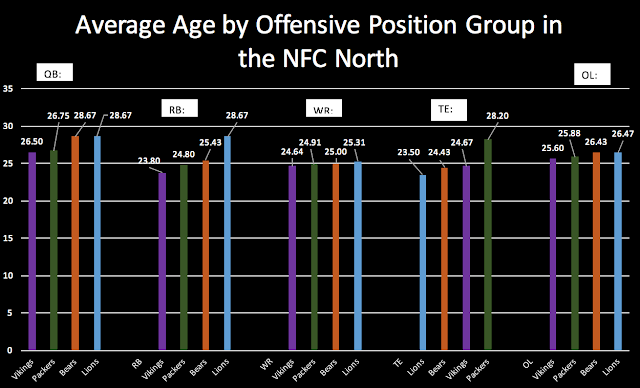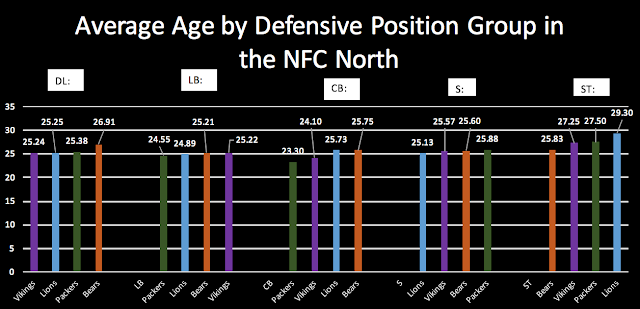Post by Purple Pain on Jun 13, 2019 18:24:36 GMT -6
Vikings Corner - A Closer Look: How Young is the Vikings' Roster?


Plenty more at the link:
www.mnvikingscorner.com/2019/06/a-closer-look-how-young-is-vikings.html
During a long and exhausting NFL season, teams with the deepest rosters can endure a laundry list of injuries. With that in mind, teams try to form a roster which features an adequate blend of youth and veterans.
In Minnesota, drafting and retaining talent has become a key philosophy for building a competitive roster. Despite adding quarterback Kirk Cousins in free agency last season, the Vikings have managed to maneuver the salary cap through creative contract structures. They have moved higher cap hits to future seasons, which has provided immediate cap relief. The front office understands there will be instances where certain veteran players eventually become cap casualties. Quarterback Kirk Cousins has only two years remaining on his fully guaranteed deal and aging left tackle Riley Reiff may be playing his final season in Minnesota. Roster decisions with both of those players, along with a veteran like defensive end Everson Griffen, give the Vikings clear options to move money over the next couple seasons. Not to mention, the salary cap is expected to increase in future seasons.
With this type of cap management, the Vikings have kept their main core together. In addition to retaining players, they have also strongly injected the roster with rookies and undrafted signings. This is an area the front office has cleared valued to create competition at all layers of the roster. It’s helped them form a young nucleus, which is scattered with veterans. For example, defensive end Danielle Hunter is only 24 years old and is already entering his fifth season in purple. Minnesota has drafted young players and developed many of them at a rapid rate, especially on defense. They’ve also managed to create a culture where players are willing to take less money to remain with the organization. This offseason, linebacker Anthony Barr turned down additional money from the Jets and tight end Kyle Rudolph mentioned the Vikings' current environment as was one of the reasons why he decided to sign a four-year, $36 million extension on Tuesday.
In the spring months, Minnesota had to continue adding youth to depth spots. It helped them withstand salary constraints associated with a quarterback that accounts for more than 15 percent of the team’s total cap space. While maintaining a veteran presence at all levels of the defense, Minnesota added youth on the offensive line to bolster overall production. First-round draft pick Garrett Bradbury joins Pat Elflein and Brian O’Neill to create a young core in the trenches. The Vikings’ front office also spent two late-round draft picks on wide receivers and defensive backs to improve depth and areas of weakness.
With the season quickly approaching and mini camp coming to a close, 90-man rosters are starting to take shape in the NFL. Of course, rosters will evolve significantly over the next couple months, but an early glance at the statistics show the Vikings have one of the youngest rosters in the NFL. After sifting through Pro Football Reference charts and adding the available rookie data, I ran several graphs to illustrate where the Vikings rank among their peers in the NFL. Minnesota currently has the third-youngest roster in the NFL (25.13 years old). They also rank second among NFC teams, trailing only the Los Angeles Rams.
In Minnesota, drafting and retaining talent has become a key philosophy for building a competitive roster. Despite adding quarterback Kirk Cousins in free agency last season, the Vikings have managed to maneuver the salary cap through creative contract structures. They have moved higher cap hits to future seasons, which has provided immediate cap relief. The front office understands there will be instances where certain veteran players eventually become cap casualties. Quarterback Kirk Cousins has only two years remaining on his fully guaranteed deal and aging left tackle Riley Reiff may be playing his final season in Minnesota. Roster decisions with both of those players, along with a veteran like defensive end Everson Griffen, give the Vikings clear options to move money over the next couple seasons. Not to mention, the salary cap is expected to increase in future seasons.
With this type of cap management, the Vikings have kept their main core together. In addition to retaining players, they have also strongly injected the roster with rookies and undrafted signings. This is an area the front office has cleared valued to create competition at all layers of the roster. It’s helped them form a young nucleus, which is scattered with veterans. For example, defensive end Danielle Hunter is only 24 years old and is already entering his fifth season in purple. Minnesota has drafted young players and developed many of them at a rapid rate, especially on defense. They’ve also managed to create a culture where players are willing to take less money to remain with the organization. This offseason, linebacker Anthony Barr turned down additional money from the Jets and tight end Kyle Rudolph mentioned the Vikings' current environment as was one of the reasons why he decided to sign a four-year, $36 million extension on Tuesday.
In the spring months, Minnesota had to continue adding youth to depth spots. It helped them withstand salary constraints associated with a quarterback that accounts for more than 15 percent of the team’s total cap space. While maintaining a veteran presence at all levels of the defense, Minnesota added youth on the offensive line to bolster overall production. First-round draft pick Garrett Bradbury joins Pat Elflein and Brian O’Neill to create a young core in the trenches. The Vikings’ front office also spent two late-round draft picks on wide receivers and defensive backs to improve depth and areas of weakness.
With the season quickly approaching and mini camp coming to a close, 90-man rosters are starting to take shape in the NFL. Of course, rosters will evolve significantly over the next couple months, but an early glance at the statistics show the Vikings have one of the youngest rosters in the NFL. After sifting through Pro Football Reference charts and adding the available rookie data, I ran several graphs to illustrate where the Vikings rank among their peers in the NFL. Minnesota currently has the third-youngest roster in the NFL (25.13 years old). They also rank second among NFC teams, trailing only the Los Angeles Rams.


As we await regular football activities in training camp, looking at age is an entertaining exercise. The numbers will likely shift a little after roster cuts and last-second signings, but we have a clear idea of how the distributions stand before battles intensify. Within a relatively young NFC North, the battle should be rather competitive for seasons to come, especially while Aaron Rodgers is still slinging it for the Packers.
A closer look at numbers and player profiles show the Vikings have a blend of veterans and youth throughout the roster. With the current contract situations they face, Minnesota's depth spots are continuing to get younger to accommodate other large financial outputs. The Vikings will need to keep developing and elevating players at depth positions to maintain a deep roster. This will help them continue to follow the "draft and retain" philosophy that has helped them develop stability. No matter how you look at it, the cap work by Anne Doepner and Rob Brzezinski has kept Minnesota's young core together. Now, it's almost time to see if they finally have all the ingredients needed to make a championship run.
A closer look at numbers and player profiles show the Vikings have a blend of veterans and youth throughout the roster. With the current contract situations they face, Minnesota's depth spots are continuing to get younger to accommodate other large financial outputs. The Vikings will need to keep developing and elevating players at depth positions to maintain a deep roster. This will help them continue to follow the "draft and retain" philosophy that has helped them develop stability. No matter how you look at it, the cap work by Anne Doepner and Rob Brzezinski has kept Minnesota's young core together. Now, it's almost time to see if they finally have all the ingredients needed to make a championship run.
Plenty more at the link:
www.mnvikingscorner.com/2019/06/a-closer-look-how-young-is-vikings.html














 ... and neither is this Chris guy.
... and neither is this Chris guy.